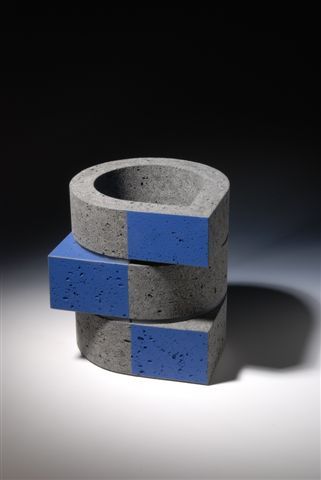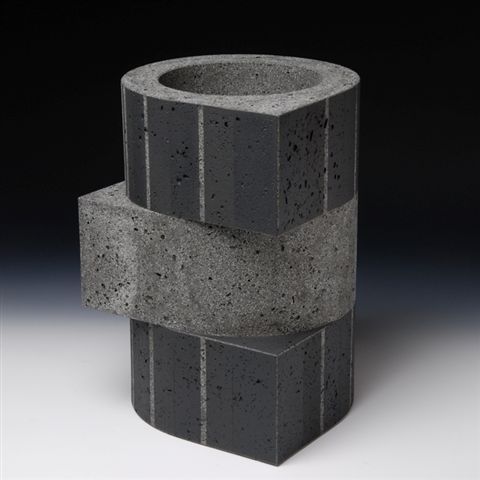
In what techniques do you usually work and what materials do you use?
My ceramic work is built from clay slabs. The clay which I am using it is a mixture of two stoneware bodies, Molochite, and flax fiber. I have developed this clay while working for European EKWC Work Center in ‘s-Hertogenbosch in 1998.
At gray/black objects, a black body stain is added. The open texture of the clay is obtained by adding organic material during the firing.
What is your present project, what’s its history and how do you make the pieces?
Currently, I am working on a new series of objects, tube / pipe structures (see photo), which will be exhibit during this year.
My technique: I begin a series/theme with a few sketches on paper or small designs in clay. Slabs leather-hard clay and cutted molded parts from a PVC / wood or plaster mold are mixed up together with clay slip. Special attention is given to the finishing of leather-hard. Once bisque fired, the object is wet smoothed with diamond pads and dried.
Glazing: parts of the object are sprayed with glaze or sinter engobes, the glaze fire in an electric oven 12600 C.
Where do you get your inspiration for your pieces and what motivates you to do a good job ?
I am inspired by the abstract geometric forms in sculptural artwork and architecture.
The inspiration is based on a systematic approach to design and execution of similar artists such as, among others, Ad Dekkers (NL), Jan Schoonhoven (NL), the architects HPBerlage (NL) and JJPOud (NL), including artists belonging to ‘the Style’ (Dutch art movement (1917-1931).
The objects refer to functional forms, such as vases and bowls, but they are never the starting point. The autonomous objects show how triangles, squares, circles and ovals are split and merged.
The main theme of the work is: “Separating and Connecting”.

Counterpoint Series 16 – View his works
What was the starting point for your research with ceramics?
I began exhibiting in 1976. The first addition of objects with Perspex slabs with ceramic, 1986. Early 90s are clearly under the influence of Greek architecture, and this can also be noticed in the titles of the objects referring to: “Sacrificial Stone “, “ Celebration”, ”Column”. Until 1998, all the work is characterized by abstract geometric and ‘rectangular’ shape.
The shape and texture of the objects changes radically after EKWC 1998 (European Ceramic Work Centre ’S-Hertogenbosch) period.
For the first time, the curve was introduced in the shape of the cylinder, circular and elliptical shape.
You give great attention to the final work and details, but when you are working on your projects, on what part are you focusing the most?
I find the esthetic side and finishing of the work very important.
Furthermore, the composition is something ‘to feel’, for example, a surprising effect at the sight of an inner and outer space, the open and closed volumes of the objects.

Where can we find you and your works in the next future?
Galeries who sell my works:
– Terra Delft Gallery, Nieuwstraat 7, 2611 HK Delft (NL) – www.terra-delft.nl
– Eewal Gallery, Czaar Peterstraat 153 hs, 1018 PH Amsterdam (NL) – www.galerie-eewal.nl
– Puls Contemporary Ceramics, Kastelijnsplein 4, b-1050 Brussels (B) – www.pulsceramics.com
More information on my website http://www.wimborst-ceramics.nl/ (News page)
Give a piece of advice for young ceramic artists.
Create your own visual language; don’t get trapped in the latest fashion trend, where everything should be sometimes large, colorful and boastful.
Adagio:
"In constraints lies the freedom.”
"Less is more.”
Wim Borst became a professional ceramist at a rather advanced age. At the age of 31 he exhibited for the first time. As a self-taught artist, he took lessons in ceramics from Ru de Boer and Emmy van Deventer a.o.
His oeuvre and career are characterized by a great accuracy and a persistent mentality. His ceramics has its roots in the Dutch geometrical abstract tradition, although he uses the idiom in a non-academic, refreshing way. Within the boundaries of the self-chosen restrictions of the geometric abstraction, he takes liberties with colors, materials, and themes. His objects are made up of different parts.
By Vasi Hirdo.
Translation by Irina Putineanu.
Published in Ceramics Now Magazine Issue 1.
View Wim Borst’s profile and C.V. (resume) – View his works
Visit the artist’s website.



















